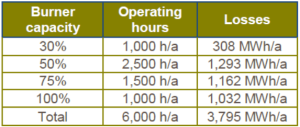The fact is the number one area of energy loss is the stack. Flue gases leaving the chimney above ambient temperature waste huge amounts of energy. You don’t have to try hard to get a feeling for the scale of problem facing the user.
In every household there’s a hair dryer, usually rated at around 1.5 kW, producing a warm gentle breeze which adds up to 12,000kWh when run for 8,000hrs. This is miniscule when compared to the hot exhaust gases being discharged from the average industrial chimney. In comparison, the hair dryer hardly produces sufficient output to scare off a cabbage white butterfly from your prize runner beans!
Anyone standing near the top of a stack, or even at ground level, when the plant is operational, cannot fail to appreciate just how much energy is contained in the huge volume of hot air racing through the flue and into the atmosphere, thus costing the operator a small fortune.
Flue gases are a fact of life and the reasons for excessive temperatures are varied but much of the heat contained within them can be harnessed by a variety of different methods.
These will be dealt with in later bulletins but suffice to say there are enormous savings to be made in this area.
Using yesterday’s technology to burn tomorrow’s energy
The savings potential for flue gas energy losses is often gigantic.
Calculation example:
Flue gas losses from a 10 MW oil-fired combustion plant operating at 15 bar with a flue gas temperature of 250°C under 24hr operation:

Tips worth consideration
[cea_button link=https://ceabackup.mlademos.co.uk/wp-content/uploads/2018/08/Flue-Gas-Losses-SAACKE.pdf]

